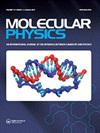Phase separation and physico-chemical variables of triton X-100 and cephradine monohydrate drug mixture: investigation of the impacts of nature of electrolytes and compositions
IF 1.8
4区 化学
Q4 CHEMISTRY, PHYSICAL
引用次数: 0
Abstract
AbstractHerein, the phase separation of triton X-100 (TNX-100) and cephradine monohydrate (CPM) drug (a first-generation cephalosporin family drug) mixture was studied in aqueous and in various aq. electrolytes (Na and K-based salts) media. As compared to the water environment, TNX 100 + CPM system demonstrated lower magnitudes of CP values in electrolytes solution. The outcomes exhibited dwindling CP values are: MCl < M2CO3 < M2SO4; (M = Na, K). Moreover, the ΔHc0 (enthalpy change), ΔGc0 (free energy change) and ΔSc0 (entropy change), compensation temperature (Tc) and intrinsic enthalpy gain (ΔHc0,∗) were also computed in the circumstances of TNX 100 + CPM mixture in water and aq. electrolytes media. The values of ΔGc0 were obtained to be positive demonstrating the non-spontaneity of the process. The ΔHc0 and ΔSc0 values were positive in aq. medium and negative in aq. salts solutions where the magnitudes ΔHc0 and ΔSc0 values decreased with the growing contents of TNX 100/salts. The results suggest that the interaction forces between TNX 100 and CPM in a water environment are hydrophobic in nature with π–π interactions whereas in aq. salts media the recommended forces are hydrophobic and exothermic forces along with π–π interactions.KEYWORDS: TNX 100cephradine monohydrateelectrolytesphase separationthermodynamics Disclosure statementNo potential conflict of interest was reported by the author(s).Additional informationFundingThis work was funded by the Researchers Supporting Project Number [RSPD2023R766] King Saud University, Riyadh, Saudi Arabia. Md. Masud Alam would like to acknowledge Mawlana Bhashani Science and Technology University, Bangladesh for providing financial support (Year 2021) to carry out a part of the research work.triton X-100与头孢定一水混合药的相分离及理化指标:电解质性质和成分的影响
摘要本文研究了triton X-100 (TNX-100)与头孢定一水(CPM)药物(第一代头孢菌素家族药物)混合物在水溶液和不同水溶液电解质(钠盐和基盐)介质中的相分离。与水环境相比,TNX 100 + CPM体系在电解质溶液中显示出更低的CP值。CP值下降的结果为:MCl < M2CO3 < M2SO4;(M = Na, K)。此外,还计算了tnx100 + CPM混合物在水和aqe介质中的焓变ΔHc0、自由能变化ΔGc0和熵变ΔSc0、补偿温度Tc和固有焓增益ΔHc0,∗。ΔGc0的值为正,表明了该过程的非自发性。ΔHc0和ΔSc0值在aqq培养基中为正,在aqq盐溶液中为负,ΔHc0和ΔSc0值随tnx100 /盐含量的增加而减小。结果表明,在水环境中,tnx100与CPM之间的相互作用本质上是疏水的,具有π -π相互作用,而在aqq盐介质中,推荐的相互作用是疏水和放热的,并具有π -π相互作用。关键词:TNX 100头孢拉定一水合物电解质相分离热力学披露声明作者未报告潜在利益冲突。本研究由研究人员支持项目号[RSPD2023R766]资助,沙特阿拉伯利雅得沙特国王大学。Masud Alam博士感谢孟加拉国Mawlana Bhashani科技大学(Mawlana Bhashani Science and Technology University)为开展部分研究工作提供财政支持(2021年)。
本文章由计算机程序翻译,如有差异,请以英文原文为准。
求助全文
约1分钟内获得全文
求助全文
来源期刊

Molecular Physics
物理-物理:原子、分子和化学物理
CiteScore
3.60
自引率
5.90%
发文量
269
审稿时长
2 months
期刊介绍:
Molecular Physics is a well-established international journal publishing original high quality papers in chemical physics and physical chemistry. The journal covers all experimental and theoretical aspects of molecular science, from electronic structure, molecular dynamics, spectroscopy and reaction kinetics to condensed matter, surface science, and statistical mechanics of simple and complex fluids. Contributions include full papers, preliminary communications, research notes and invited topical review articles.
 求助内容:
求助内容: 应助结果提醒方式:
应助结果提醒方式:


